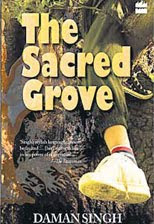A game of cricket in the lawns of his house confronts the narrator of this novel, Ashwin, a 12-year-old boy with a dilemma. He has to answer at that very moment whether he is still a child. “No, I am not”, is Ashwin’s defiant response. Thus the story takes off.
The Sacred Grove is set in a small Indian town where Ashwin’s father is the district collector. Thanks to the government, as Ashwin says, they had the best house in town and it was not much of a town any way, with three main roads and no red lights. But Ashwin liked the town; it had heart, it had soul, people believed in the same things. That was what Ashwin and the driver Rafiq thought.
Though there is an inconsequential temporal sequence in the book, it is Ashwin who decides which incidents in his life he wants the reader to know. He chooses as he pleases and his concern is with the “here and now” told in the language that he speaks.
The story begins with Ashwin’s mother’s unexpected pregnancy. When his father tries to explain it to him, Ashwin is dismissive because he has learnt all that he needed to learn about reproduction in school. The narration continues with Ashwin’s triumphs in computer games and cricket, he describes his humiliation in football with unflinching honesty when he manages to kick the ball into his own goal. “My life stank. I wanted to die.” Ashwin is the urban middle-class everyboy.
Full report here Deccan Chronicle

No comments:
Post a Comment